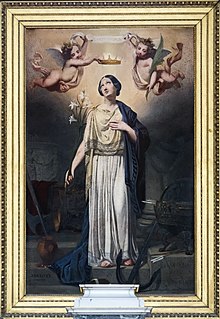Philomena
| Saint Philomena | |
|---|---|

Saint Philomena Montauban Cathedral
|
|
| Virgin and Martyr | |
| Born | c. January 10, 291 (?) Corfu, Greece (?) |
| Died | c. August 10, 304 (aged 13) (?) Rome, Italy |
| Venerated in | some local calendars of the Catholic Church from 13 January 1837 until 14 February 1961 |
| Canonized | 1837 by Pope Gregory XVI |
| Major shrine | Church of Our Lady of Grace in Mugnano del Cardinale |
| Feast | 11 August |
| Attributes | Youth, palm of martyrdom, flower crown, orange or white robes, palm, arrows, anchor, sometimes a partially slit throat |
| Patronage | Children, youth, babies, infants, priests, lost causes, sterility, virgins, Children of Mary, The Universal Living Rosary Association, Sibonga, Cebu |
Saint Philomena was a young lady whose remains were discovered on May 24/25 1802 in the Catacombs of Priscilla. Three tiles enclosing the tomb bore an inscription (Pax Tecum Filumena) (i.e."Peace be to you, Philomena") that was taken to indicate that her name (in the Latin of the inscription) was Filumena, the English form of which is Philomena. Philomena is the patron saint of infants, babies, and youth.
The remains were removed to Mugnano del Cardinale in 1805 and became the focus of widespread devotion, with several miracles credited to the saint's intercession, including the healing of Venerable Pauline Jaricot in 1835, which received wide publicity. Saint John Vianney attributed to her intercession the extraordinary cures that others attributed to himself.
In 1833 a Neapolitan nun reported that in a vision Saint Philomena had revealed that she was a Greek princess martyred at 13 years of age by Diocletian, who was Roman Emperor from 284 to 305.
From 1837 to 1961 celebration of her liturgical feast was approved for some places, but was never included in the General Roman Calendar for universal use. The 1920 typical edition of the Roman Missal included a mention of her, under 11 August, in the section headed Missae pro aliquibus locis (Masses for some places), with an indication that the mass to be used in those places was one from the common of a virgin martyr, without any collect proper to the saint.
On 24 May 1802, in the Catacombs of Priscilla on the Via Salaria Nova, an inscribed loculus (space hollowed out of the rock) was found, and on the following day it was carefully examined and opened. The loculus was closed with three terra cotta tiles, on which was the following inscription: lumena paxte cumfi. It was and is generally accepted that the tiles were in a wrong order and that the inscription originally read, with the leftmost tile placed on the right: pax tecum Filumena (i.e."Peace with you, Philomena"). Within the loculus was found the skeleton of a female between thirteen and fifteen years old. Embedded in the cement was a small glass phial with vestiges of what was taken to be blood. In accordance with the assumptions of the time, the remains were taken to be those of a virgin martyr named Philomena. Her name means Daughter of Light. She was canonized in 1837. Philomena is the patron saint of infants, babies, and youth.
...
Wikipedia
